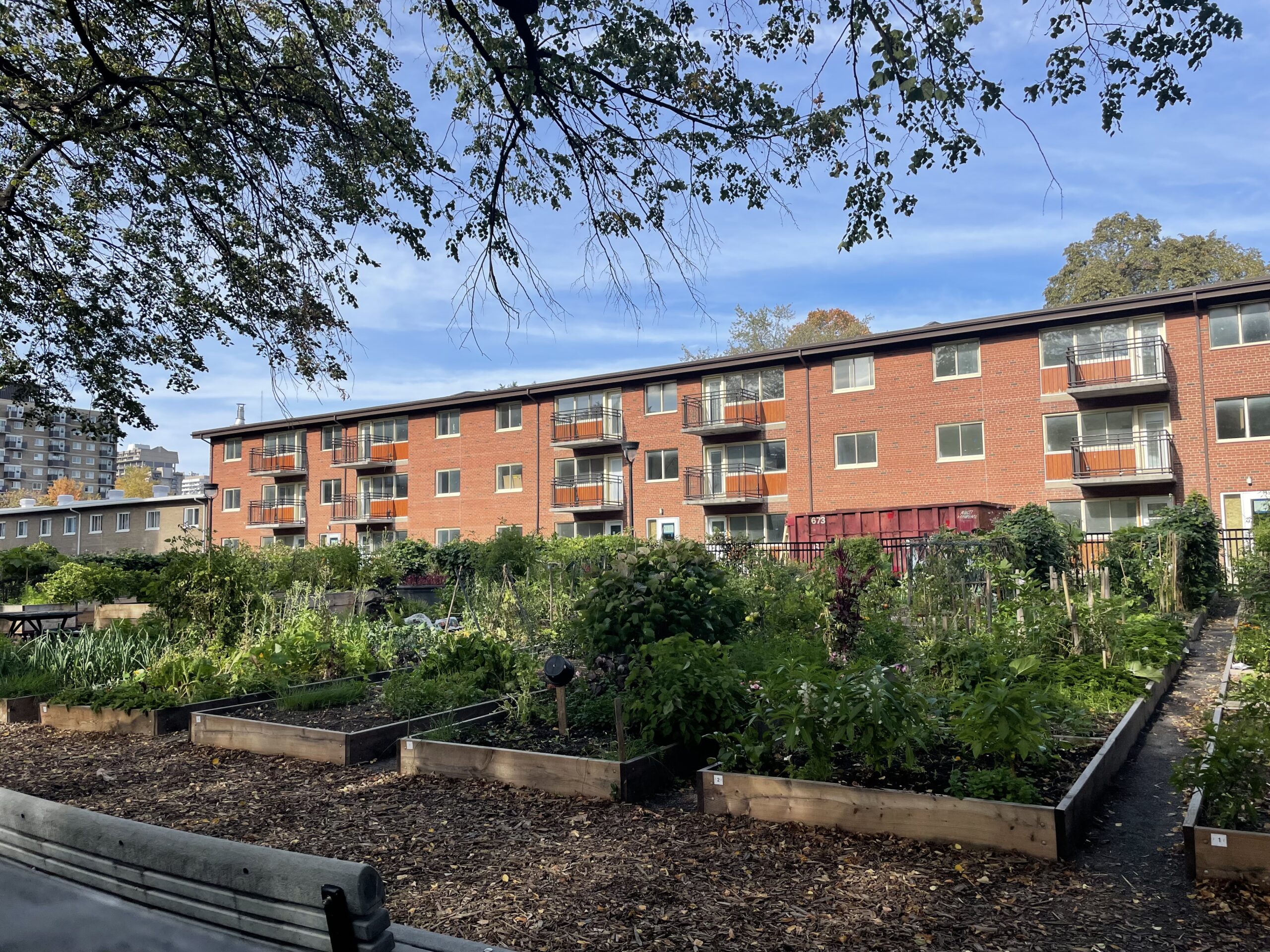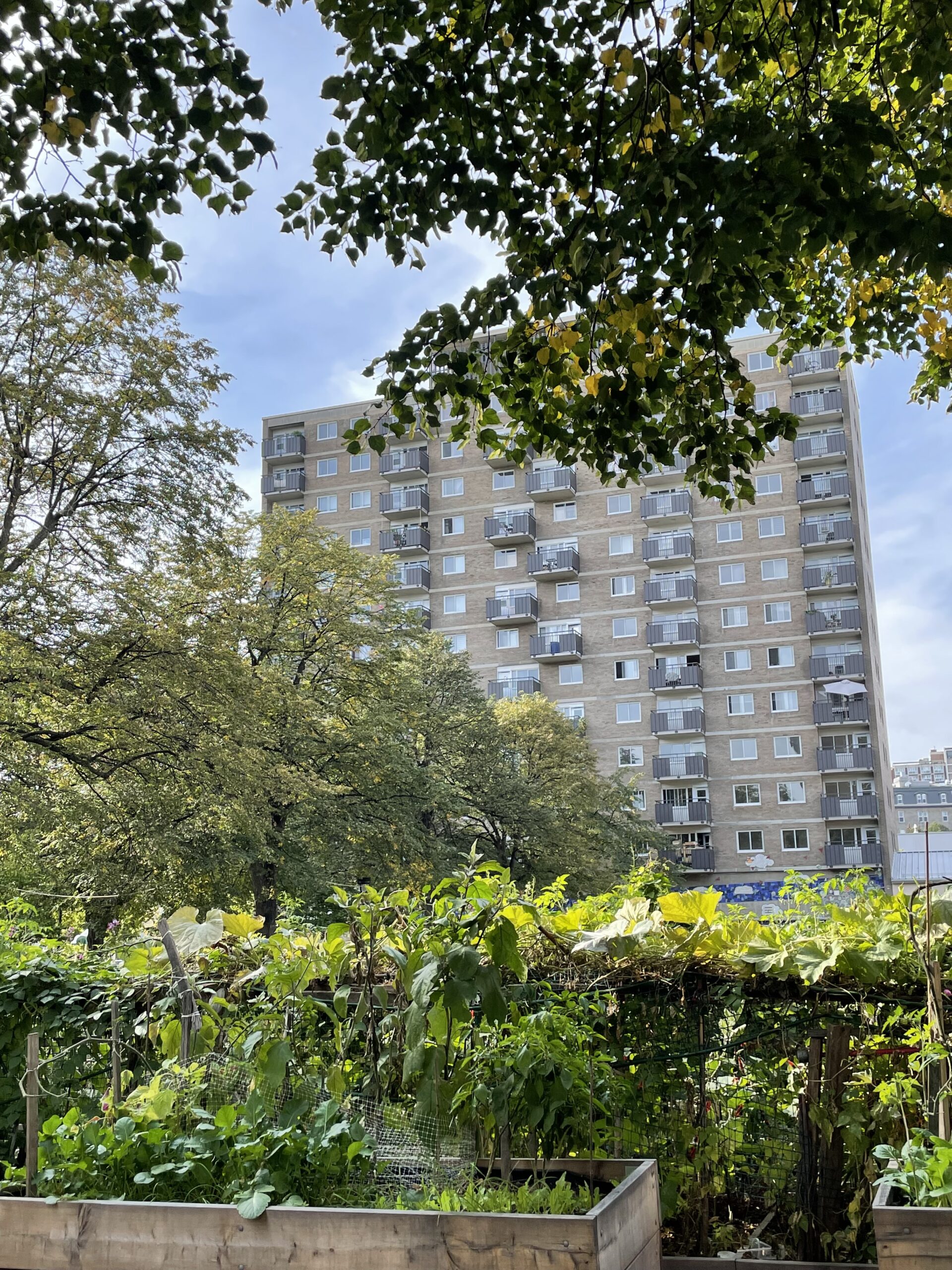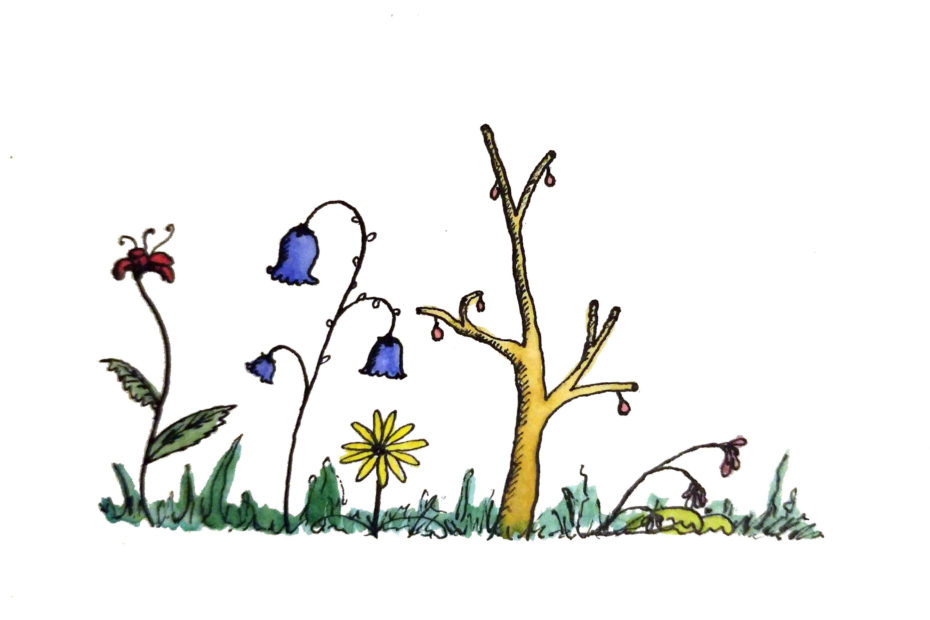Geneviève Dubé of the Toit Vert Solidaire, a group created by the Milton Parc Green Committee and the Milton Parc Citizens’ Committee, spoke to the Daily about community gardens and urban agriculture initiatives in Montreal. The Toit Vert “was created to create connection between people in the community, empower people to fight for food security and to create a sense of belonging,” says Dubé, describing the garden as a “collective learning experience” that, if given the resources, could actually be a meaningful food source for low-income households.
Located on De Maisonneuve Boulevard in Borough Ville-Marie, a few blocks from the Saint-Laurent metro station, the community garden of Habitations Jeanne Mance is brimming with flowering plants, onion tops, and tomato vines. The City of Montreal currently maintains 97 community garden sites, the number varying per neighbourhood – one garden per 61 households in Mercier-Hochelaga-Maisonneuve, one per 113 households in Ville-Marie, and one per 149 households in the Plateau-Mont-Royal neighbourhood, according to Dubé.
Habitations Jeanne Mance is Quebec’s oldest public housing project, and its garden offers residents lower-cost access to fresh produce through purchasing a plot. Plots are allocated by street address, and gardeners are provided with soil, compost, gardening tools, and a watering source. Gardeners must follow a variety of rules, including maintaining the garden through regular weeding within their plots and along pathways, checking for pests and invasive plants, and participating in scheduled clean-ups. Community gardens are essential food services in low-income and marginalized communities. In Ontario, gardens were officially declared to be essential food services during the first wave of the COVID-19 pandemic as the province announced the closure of recreational spaces, which initially included community gardens. Fresh produce grown and accessed by a neighbourhood community has been shown to increase the proportion of vegetables in diets, to have benefits for physical and mental health and well-being through fostering active involvement in gardening as an outdoor physical activity, and to foster connection with other members of the community.
Unfortunately, residents can expect to be on the waitlist for years before having access to a garden plot. Dubé reported to the Daily that wait times for a plot in Plateau-Mont-Royal are generally three to five years, according to 54 per cent of respondents – while some have been waiting for two years (19 per cent), and others for six to ten years (16 per cent). Borough councillors have expressed that expansion of urban agriculture is obstructed due to the limited availability of public land. According to Dubé, garden plots in De Lorimer and Mile End neighbourhoods are divided in two to accommodate more gardeners – but this is not an adequate solution. More land needs to be allocated for urban agriculture initiatives, addressing the cause of long wait lists rather than implementing a temporary solution that divides the already limited space there is. Dubé emphasizes that “we cannot relate community gardens to food security if we don’t have the space to develop them.” Currently, the community gardens in Montreal emphasize the individuality of plot ownership: the rules state that although “gardeners may help one another on occasion,” they “may not work on another gardener’s plot on a regular basis.” And although plots are allowed to have a co-gardener, there can only be one and they can only serve as a temporary replacement for the main gardener. This restriction of one-gardener-per-plot, which has contributed to the reduction in plot sizes, severely limits the potential reach of urban gardens within their existing space and number. In order to shorten wait times and allow more people to engage with the garden, the Toit Vert recommends “offer[ing] options for collective gardening or involvement in other urban agriculture projects.” Collective gardening differs from community gardening in that a group of people cultivate the garden together rather than own individual plots. Without increasing the amount and size of gardens, such a collective approach to gardening could better accommodate marginalized communities who would benefit from urban agriculture.

Dubé imagines urban gardens to be a pathway toward a sustainable food system in which the “production, processing, distribution, [and] consumption of food products as well as the management of residual materials” are integrated into a local and collaborative network. Dubé attests that a 2021 survey by the Urban Agriculture Lab of Plateau-Mont-Royal found that “vegetables grown in community gardens contribute to a good proportion of fresh fruit and vegetable consumption for some members, but – unfortunately – not enough to fully feed their households. Fruits and vegetables from the community garden represent between 25 per cent and 49 per cent of the total fruits and vegetables they eat during the growing season for 30 per cent of survey respondents.” Although this is a substantial increase from just the past two years, gardens are not currently a reliable food source because they are not allowed the space to grow. If gardens were to be adequately publicly funded and meaningfully expanded, the future could look like a garden in every neighbourhood. Dubé hinted at potentially establishing a garden for the Milton Parc community at the “Royal Vic site,” what used to be the Royal Victoria Hospital, land which McGill currently plans to privatize and convert into a Sustainability Sciences and Public Policy centre.
Funding
In February, the City of Montreal announced an investment of $10 million over the next 10 years for urban agriculture projects. The money will be put toward the renovation of gardens, expansions, and the installation of compost bins. In order to access this funding, boroughs can submit proposals to the Office of Ecological Transition and Resilience. As well, Montreal’s 2021 to 2026 Urban Agriculture Strategy notably aims to expand cultivated land from 120 hectares to 160 hectares, to develop urban agriculture in schools, and to increase the number of urban agricultural businesses. Magali Casaubon, the Urban Agriculture Program Manager at Santropol Roulant, speaks to the shortcomings of the plan: “it is important to remind the city that in order to move forward with the AU 2021–2026 super strategy, it must also ensure that it provides funding for human resources, particularly for community organizations that are already active and supported by individuals who are living with job insecurity from season to season.” The city has also been a proponent of “unconventional” greening initiatives, such as in alleyways known as “Ruelle Verte.” Although this could aid with the urban heat island effect (UHI), growing in alleys is not effective on a larger scale due to limited water and sunlight. As well, green alleys have contributed to “urban renewal,” also known as gentrification, efforts. Dubé added that “the Milton Parc community has been waiting to get its own community garden” because the Toit Vert as well as other green initiatives across Milton Parc are “great projects, but they do not address food security needs.”
Gentrification
However, greening initiatives across Montreal – notably, the conversion of industrial land by the Lachine Canal into recreational space with bike and walking paths following its designation as a national park in 1976 – has provided sought-after green infrastructure that facilitates gentrification through land speculation and eviction of low-income residents. Publicly-funded greening projects promoted by activists and borough councillors as well as those involved in the Eco-quartier program, have inadvertently displaced low-income and racialized populations while being ineffective in addressing the issues they intend to. Ville en Vert, a project funded by Eco-quartier to combat the UHI, in the Villeray-Saint Michel-Parc Extension is one such example of this. The project was initiated to reduce the UHI, which occurs when densely paved and constructed areas of a city absorb and retain greater UV radiation than vegetation and natural land cover would, resulting in higher overall temperatures in densely urban areas with little green space. This increases energy costs for air conditioning, pollution levels, and, in some cases, heat-related illness.
A 2021 research paper titled “The Impacts of Green Gentrification on Homelessness; Urban Greening and Displacement in Parc-Extension Neighborhood of Montreal” reported, however, that the developers of the Ville en Vert project did not consult Parc-Extension residents or local organizers regarding the project in terms of adequately addressing the sustainability needs of the community. Residents and organizers expressed feeling disappointed with the organization of the program, citing that it failed to integrate feedback, lacked the capacity to invoke environmental change residents could actually benefit from, and had no intention of reflecting the needs of residents. Environmental concerns, such as UHI, ultimately need to be addressed as intersectional social issues – undesirable land uses, zoning, and toxic waste disposal, among other environmental decisions, have historically deliberately targeted and disproportionately affected low-income people and people of colour, especially Black and Indigenous peoples. The paper cited that the Ville en Vert project “did not emerge as a solution designed to address the problem of UHI in its complexity but rather as a result of applying a pre-existing solution to a ‘problem’ that is high on the political agenda,” and its adverse “inadvertent” effects of intensifying gentrification outweigh its negligible effects on the UHI. The city’s transformation of alleys into “Ruelle Verte,” in the absence of meaningful rent control, have had a similar effect. In order for greening projects to be beneficial, it is essential that projects are community-led or that members are given a seat at the table, in tandem with anti-gentrification efforts, housing rights, and ways to address other socio-economic needs.
Accessibility
Gardens across Montreal have a varying number of plots which are accessible to people with disabilities. There are many ways to make gardens more physically accessible for people with disabilities as well as for anyone unable to crouch for long periods of time – ultimately increasing community involvement in the garden space. Along main pathways and entrances within the garden, accessibility measures should maintain smooth paths that are wide enough for a wheelchair or have accessories such as ramps and railings. Additionally, vertical gardening techniques and raised-beds allow gardeners to stand or sit on a chair, rather than crouch – such beds of varying heights are implemented at the Santropol Roulant. Beds can also be elevated to allow a wheelchair to be positioned underneath the planter while the gardener has access to the entirety of the bed. Ultimately, more needs to be done across the community gardens of Montreal to ensure improved physical access.

Engaging in Urban Agriculture
To start your own garden, look to the Macdonald Campus Seed Library, which allows students to borrow a variety of flower, herb, and vegetable seeds with the option to “return” them at the end of the season. Volunteer with the Santropol Roulant and participate in the activities of the Toit Vert Solitaire (join the Facebook group: Les Jardins collectifs de Milton Parc / Milton Parc Community Gardens). Further, students can advocate against the privatization of the Royal Vic and in favour of keeping the land in the public domain, democratically managed to serve the social, economic, and ecological needs of Milton Parc residents.
The potential that urban gardening has in creating sustainable and community-based food systems in Montreal is immense. Although gardens wouldn’t be able to operate for around six months of the year, the summer and fall months could serve as a time of cultivating connection between people and between the earth through digging, weeding, shovelling compost, planting lettuce and watching it grow, and taking a squash home only to realize its the best-tasting squash of your life. However, the development of gardens has real limitations, such as funding, space to allow expansion, and the physical accessibility of the garden space. As well, it is important to consider the possible gentrifying effects that gardens can have. Although gardens are in line with the needs of residents in various neighbourhoods, as indicated by the hundreds of people on the waitlist for a plot, greening initiatives coupled with poor rent control across Montreal have historically raised property values and resulted in the eviction of low-income residents. As a participant of a garden collective has said via Dubé, “Having a garden would make my life very happy every day. Meeting my neighbours, taking care of the plants, sharing my harvests by preparing meals for my friends and relatives, the magic of seeing what I have planted grow day after day.”

